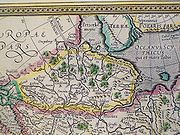
Qashliq
Encyclopedia

Tatar language
The Tatar language , or more specifically Kazan Tatar, is a Turkic language spoken by the Tatars of historical Kazan Khanate, including modern Tatarstan and Bashkiria...
: Qaşlıq or İskär) was a medieval
Middle Ages
The Middle Ages is a periodization of European history from the 5th century to the 15th century. The Middle Ages follows the fall of the Western Roman Empire in 476 and precedes the Early Modern Era. It is the middle period of a three-period division of Western history: Classic, Medieval and Modern...
(14th-16th century) Siberian Tatar fortress, in the 16th century the capital of the Khanate of Sibir, located on the right bank of the Irtysh River at its confluence with the Sibirka rivulet, some 17 km from the modern city of Tobolsk
Tobolsk
Tobolsk is a town in Tyumen Oblast, Russia, located at the confluence of the Tobol and Irtysh Rivers. It is a historic capital of Siberia. Population: -History:...
.
The fortress is first mentioned in Russian sources of the 14th century.
The period of the most development was in the first half of the 16th century. In 1582 the troops of Cossack
Cossack
Cossacks are a group of predominantly East Slavic people who originally were members of democratic, semi-military communities in what is today Ukraine and Southern Russia inhabiting sparsely populated areas and islands in the lower Dnieper and Don basins and who played an important role in the...
ataman
Ataman
Ataman was a commander title of the Ukrainian People's Army, Cossack, and haidamak leaders, who were in essence the Cossacks...
Yermak seized and ruined Qashliq. The ruined city was retaken by the Tatars in 1584 only to be lost forever in 1586. The nearby city of Tobolsk
Tobolsk
Tobolsk is a town in Tyumen Oblast, Russia, located at the confluence of the Tobol and Irtysh Rivers. It is a historic capital of Siberia. Population: -History:...
was founded in 1587. The former Sibirka rivulet today is reduced to a dense swampy forest.
The name Sibirka was probably named from the name of the fortress (and not vice versa), the name Sibir being of unknown etymology, but itself the source of the name of Siberia
Siberia
Siberia is an extensive region constituting almost all of Northern Asia. Comprising the central and eastern portion of the Russian Federation, it was part of the Soviet Union from its beginning, as its predecessor states, the Tsardom of Russia and the Russian Empire, conquered it during the 16th...
.
Sources differ on the exact location of the fortress. Most give the distance upriver from Tobolsk as 17 or 18 km, or verst
Verst
A verst or werst is an obsolete Russian unit of length. It is defined as being 500 sazhen long, which makes a verst equal to 1.0668 kilometres ....
s, or ten to eleven miles, but others give 23 km. Sources of the early 19th century claim that the ruins of the fortress could still be made out with difficulty.
The ruins of Qashliq, when they were still visible, were also referred to as The Fort of Kuchum
Kuchum
Kuchum khan Kuchum khan (Tatar: Küçüm, Күчүм, Russian: Кучум; in Sybyr Küçüm is pronounced approximately as /kytsym/ - Күцүм, English name comes from standard Tatar pronunciation)Kuchum khan (Tatar: Küçüm, Күчүм, Russian: Кучум; in Sybyr Küçüm is pronounced approximately as /kytsym/ - Күцүм,...
by Russians.
The modern village of Sibiryak is located close to the site.
External links
- Photograph of the approximate site (Ant-13 at PanoramioPanoramioPanoramio is a geolocation-oriented photo sharing website. Accepted photos uploaded to the site can be accessed as a layer in Google Earth and Google Maps, with new photos being added at the end of every month. The site's goal is to allow Google Earth users to learn more about a given area by...
)

